An elderly man entering a hospital for tests is asked about his food
preferences. “I eat anything,” he responds, which turns out to be
untrue. He eats anything within the narrow range of what his wife
serves him.
The unexamined life may not be worth living, but it’s easier on the digestive tract.
Art
critics say they make aesthetic judgments about art, not about whatever
political content might serve as its subject matter. This stance is
easy for the typically leftist critic, because virtually all art with
overt political content comes from the left. It’s against the usual
negatives (war, racism, sexism, concentrated wealth, wasteful carbon
footprints) and in favor of the usual affirmatives (civil rights, human
rights, economic justice, social diversity and so forth.)
Happily I proceed, unchallenged, until considering the work of Charles Krafft. (Or, recently, nostalgic/romantic art
about Boy Scouts.) In both cases, I find that I am not as open-minded
as I think I am; that when it comes to political content, I am not
open-minded at all.
Krafft is having an accidental career survey at a resale gallery known as Seattle ARTresource, with a dozen paintings from the 1980s onward and 18 hand-painted ceramic plates from his Disasterware series.
Seeing
a fair sample of Krafft’s plates together for the first time in years,
I was struck by their secret narrative. They are an extended version of
the artist’s self-portrait, featuring the prickly ground of his
compulsion to offend.
To a Nazi-loving skinhead who told the artist he was his hero, Krafft replied,
I can’t imagine why. I’m making fun of you people.
More accurately, Krafft is making fun of everybody, including himself.
In 1992, when he had his last exhibit in a mainstream Seattle gallery (Davidson), Sam Davidson told me he was troubled by his own insistence that one of Krafft’s Disasterware plates not be in the show. After taking a look at the censored plate, I said, “Good call.”
I
use the word censored lightly. It isn’t censorship for a dealer to
decline to exhibit a particular artwork within a show featuring that
artist. It’s called curating. But curating to avoid giving offense
rightly troubled the dealer.
Created on the heels of the Rodney
King verdict and the Los Angeles riots, the piece struck me as
unbelievably racist. I didn’t write about it, being stumped as to what
to say and how to phrase it for placement in the PI. There was no way
the PI would have reproduced the image unless it were accompanied by a
ringing denunciation.
(Click images to enlarge.)
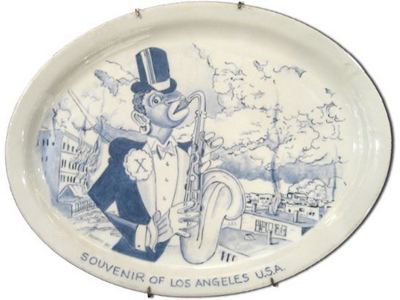 What
What
if instead of an African-American minstrel who plays the sax as LA
burns, the figure is a self-portrait, a slighted caricature of a
marginalized group – those who make art as the world goes to hell?
What
if the hostility is directed at himself? At the time, he was a Seattle
artist approaching middle-age with little hope of a wider audience;
passed over, ignored, full of rage, wicked glee and self-loathing. What
does the plate “mean” in this context?
What did it mean when Philip Guston began drawing himself
as a member of the KKK? However startling, it wasn’t controversial to
be sick of self, sick of America and in despair about the Viet Nam War.
Art. What is it good for? In order say “absolutely nothing,” Guston had to continue to make it.
During
a studio visit in the mid-1990s, Krafft put the plate below in my lap.
Immediate unease overcame me. He said he modeled the figure from a
photo featuring a Jewish victim of Nazi experiments. The man was not
not high. He’s dead.
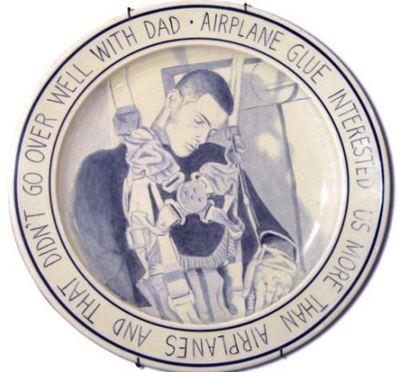 I
I
told Krafft to get this thing off me, as I didn’t want to touch it.
Being Pop jaunty about mass murder didn’t work for me. It worked for
Mel Brooks, but he didn’t have images of actual victims on stage. Try
to hum Springtime for Hitler while looking at this plate.
Krafft
is the outsider son of an affluent and right-wing Seattle family. While
his father saluted the flag, Krafft took drugs and got kicked out of a
high school. In response, his dad was not above expressing parental
frustration with his fists. If Krafft is the model in the center, the
text makes sense.
AIRPLANE GLUE INTERESTED US MORE THAN AIRPLANES AND THAT DIDN’T GO OVER WELL WITH DAD.
Below, Krafft’s version of a commerative plate. His dad would have liked the original.
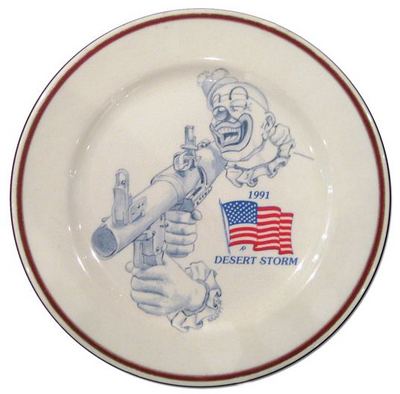 Krafft was midway in the journey of his life when he found himself
Krafft was midway in the journey of his life when he found himself
lost in a dark wood. He was painting in the mystic tradition of the
Northwest School after the school had closed. Mark Tobey was dead. Morris Graves was holed up in his Northern
California retreat. Guy Anderson was still in La Conner but
uninterested in reviving an art movement. He focused instead on the
celestial weather he was creating in his own work.
Krafft needed a movement, so he made one up.
Partly inspired by Seattle musicians (Nirvana, Pearl Jam,
Soundgarden) and partly by his friend, the L.A. auto pin-striper known
as Van Dutch, Krafft created his own version of Seattle Noir.
In 1991, he debuted his Disasterware, with famous scenes of
carnage painted in the kitsch style of tourist Dutch dinnerware. He
followed with his Metropolitan Mobile Museum truck show, titled, Charles Krafft, 1974-1994: The Happy Years.
He honored Morris Graves by founding the “Mystic Sons of Morris Graves, Lodge Number 93,” emphasizing the antic
side of the dreamy flower painter and delighting him in his old age.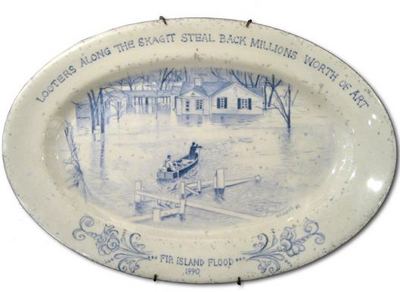 Looters steal back. Krafft wants it back, everything he tried to be among the bastards out there.
Looters steal back. Krafft wants it back, everything he tried to be among the bastards out there.
Not
in the current sampling of his work at Seattle ARTresouce is anything
from his Delftware weaponry, his mad-cow creamers, his human bone
china, Hitler teapot or Holland windmills with swastika-shaped blades.
What
does this artist want? Maybe the key is a white ceramic bar of soap
with the word “forgiveness” impressed on its surface, along with a
swastika.
It’s a tribute to Slovenian artist Peter Mlakar, who said as he and
Krafft gazed out across a wrecked Olympics village in Sarajevo during a
cease-fire:
I love the smell of blood on the snow. If I could bottle
that scent, I’d create a new fragrance for the 21st century and call it
forgiveness.
Krafft says he has a few things in a show that opens in Seattle Thursday night, 7-9, at Porcelain Studio, 1020 1st Ave.
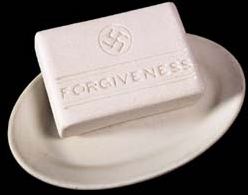



Leave a Reply